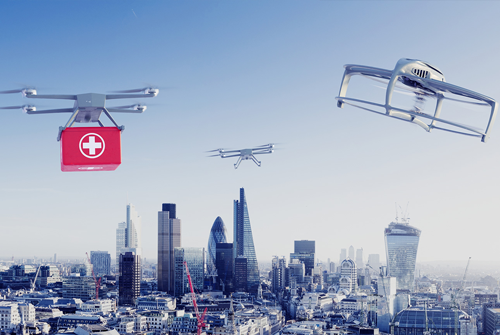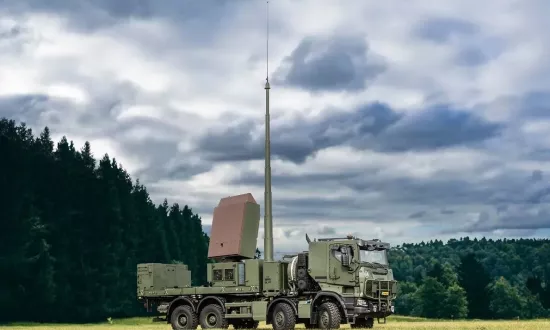Thales helps bring UTM to NBEC and the UK
In December, Thales and its partners in the National BVLOS Experimentation Corridor (NBEC) consortium performed the first end-to-end beyond visual line of sight (BVLOS) drone trials along the entirety of the NBEC. This 16km-long corridor, stretching from Cranfield University’s Global Research Airport to Oakley in Bedfordshire, is also part of the CAA’s Innovation Hub Sandbox initiative. Its aim: to provide a safe, managed and scalable environment in which to test BVLOS infrastructure, platforms, sensors and airspace-management systems.
The NBEC environment incorporates several surveillance and tracking capabilities to provide a fused situational awareness picture to allow BVLOS operations. The experiment involved monitoring a drone along the flight corridor, using air and ground sensors (including Aveillant’s holographic radar) to track and manage its return journey. The flights also included a simulated airspace encounter to test avoidance manoeuvres during the ‘en-route’ flight phase.

Another experiment tested the drone’s “electronic conspicuity” procedures – so operators know exactly where it is at all times, and that it can act safely and appropriately. For example, if it loses its communications link, does it hover where it is, go to ground, or return home?
The challenge of scaling
Managing a single drone flying low-level on a pre-determined flightpath along a clearly defined volume of airspace authorised by the CAA, is a significant achievement. It’s another step closer to developing the infrastructure and systems required to track and manage myriad other potential users flying in unsegregated airspace between 400 and 10,000 feet. These include hot-air balloons, paragliders, helicopters, and general aviation, plus the 76,000 other drones PwC predicts will be flying in UK airspace by 2030.
Consider the UK’s already congested skies and the scale and complexity of the challenge ahead to ensure the safe co-existence of manned and unmanned air vehicles operating in new airspace structures becomes clear. To happen safely, this integration requires processing huge amounts of data generated by ground and air sensors. And that requires cutting-edge infrastructure, secure and high-capacity communications enablers, as well as advanced unmanned traffic management (UTM) systems to dynamically manage and control the airspace.
This is why consortia like the NBEC partnership are so important. They bring together the wide range of experience and expertise needed to seamlessly research, test and knit together these technologies and systems, because no one or two organisations can do it all.
UTM in the UK
In early 2022, Thales will be deploying its UK-tailored TopSky UAS product at Cranfield DARTeC. This will build on the the solution currently supporting drone operations in Lille and Rennes in France. It will also draw on our experience building the communications and surveillance infrastructure for North Dakota’s state-wide Vantis BVLOS network, which has become the “benchmark” proving ground for testing, training and commercialising unmanned aircraft systems in the US.
Everyone in the drone community understands we’re still in the early stages of creating a new and enduring aviation market sector. The CAA continues to build a body of evidence to underpin future decisions and recommendations on how to best manage the airspace to allow drone operations at scale. In 2022, we’ll significantly ramp up our own contribution to UTM operations and continue to work closely with the CAA, other stakeholders, and our consortia partners, to develop UAV systems and enabling technologies, along with regulatory frameworks, certification and security.

Onwards and upwards
The success of the NBEC’s first phase iterative trials shows that safe and consistent BVLOS operations are possible. And while the trials show we’re still in the learning phase, they’ve also shown how the NBEC consortium is helping to develop the future regulatory environment.
Thales has a strong record in taking on and overcoming difficult challenges such as building infrastructure, cyber resilience, scalability, certification and safety. Add to this our ability to apply our global air traffic management (ATM) and proven experience to tackling the big challenges of large-scale drone adoption.
That’s why we're investing significantly in our UTM capability in the UK to address the big challenges to large-scale drone adoption and working with other consortia besides NBEC, such as the Future Flight Challenge Airspace of the Future (AoF) and HADO (High-intensity Autonomous Drone Operations).
AoF is an ongoing Future Flight Challenge project to develop routine sustainable drone regional and national services in a safe coordinated environment that’s mindful of end-user requirements, validated by strong business cases, synthetic and physical demonstrations, and stakeholder and public engagement. HADO is part of Future Flight Challenge 3 and focuses on developing autonomous drone technologies, skills, procedures, evidence and approvals to complete a four-month trial of drone services.
While these consortia work to prove the infrastructure, technology, and regulations, the economic business use case is yet to be proven to realise the true economic and societal benefits of drones. That requires deploying drones in the real word to, for example, survey power lines, support large-scale logistical delivery operations, inspect blades on wind turbines, fly emergency supplies to hospitals, monitor traffic, search for lost hikers, or a thousand-and-one other applications.


